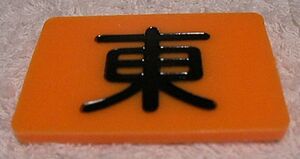Mahjong equipment
A physical game of Japanese mahjong is normally played with a set of 136 tiles, along with a few other pieces of equipment, such as dice and game mats. When playing online, there is no need to consider equipment.
Japanese tiles
Japanese mahjong sets usually come with 144 tiles in a case. Japanese tiles are usually about the size 16 mm x 19 mm x 26 mm (WLH), and are capable of standing on their own. The tiles are often dual colored, with the backs sharing the same color.
136 of the 144 tiles are used for Japanese mahjong itself, leaving 8 tiles left unused:
- 4 red fives: one for manzu and souzu, and two for pinzu. To use these, replace a copy of each of the regular fives with the red fives of the corresponding suit. Games are typically played with 3 red fives, leaving the second red 5p out of the game.
- 4 flower tiles. These may be used as nukidora.
Of the 136 tiles in play, there are 34 unique types of tiles, with 4 copies of each type. The tiles may be subgrouped into further categories:
- Number tiles (27 types): There are three numbered suits - Manzu, Pinzu, Souzu. Each suit has tiles numbered from 1-9. The three numbered suits are mostly identical, but each tile group must be formed with one suit (though a hand can have multiple suits). Number tiles can be used in sequences.
- Honor tiles (7 types): There are two distinct groups of honor tiles. All honor tiles cannot be used in sequences.
- Winds (4 types): East, South, West, North. Wind tiles are unique as their value changes with the round wind and seat wind.
- Dragons (3 types): White (Haku), Green (Hatsu), Red (Chun).
All tiles listed below follow the order used for dora.

Man
| Ii wan | Ryan wan | San wan | Suu wan | Uu wan | Rou wan | Chii wan | Paa wan | Kyuu wan |
Manzu 「萬子」, or man/wan 「萬」 for short, composes the character tiles. Each tile displays two characters. A Chinese character or Japanese kanji are used to indicate the numbers 1-9 on the upper side of each tile. The lower character on each tile means "ten thousand". While some sets have the alphanumeric representations of the numbers superscript on the upper right corners, standard Japanese sets lack these alphanumeric superscripts. For such sets, it is best to memorize the kanji for 1-9.
Pin
| Ii pin | Ryan pin | San pin | Suu pin | Uu pin | Rou pin | Chii pin | Paa pin | Kyuu pin |
Pinzu 「筒子」, or pin 「筒」 for short, composes the coin or circle tiles. The symbols represent the use of coins.
Sou
| Ii sou | Ryan sou | San sou | Suu sou | Uu sou | Rou sou | Chii sou | Paa sou | Kyuu sou |
Souzu 「索子」, or sou 「索」, composes the bamboo or stick tiles. Ordered 1-9, it is special to note the 1-sou tile which is marked with a large bird instead of 1-stick, to discourage cheating by tile alteration.
Winds
| Ton | Nan | Shaa | Pei |
Kazehai 「風牌」, or winds, include four types of tiles: East, South, West, and North. The wind tiles correlate to the player seating, and so therefore, it is best to remember the wind tiles in the East, South, West, and North order, as they correspond to the seating order. Likewise, this is significant to note for yakuhai.
Dragons
| Haku | Hatsu | Chun |
Sangenpai 「三元牌」, or dragon tiles in English, consist of white, green, and red. Just noting their color is sufficient enough for play.
Mats

Mahjong mats are used to provide mahjong tiles a softer surface to slide all over, thus protecting the tiles from wear and tear. Mats come in various sizes, but they are all square shaped. Junk mats provide a plastic perimeter with slots for point sticks.
Tenbou
Tenbou 「点棒」 are the point sticks used to keep track of points. When points are exchanged between players, tenbou are used to facilitate said exchange. Gambling games may tie these point sticks to money.
Chips (e.g. poker chips) may be used instead of tenbou, so long as their values are agreed beforehand.
Dice
Two dice are used to determine the wall break at the start of each hand.
Round indicator

A dealer marker is used throughout the game to either indicate the current dealer, or the initial dealer. In the case of the latter, the dice are used to indicate the current dealer, as it gets passed around from one dealer to the next. It is also used to indicate the current round, either the East Round or South Round.
Automatic tables
Automatic mahjong tables are used to expedite the process of tile shuffling and wall building. With the push of a button, players can save time as the wall building process is performed by machine.
Playing cards
Mahjong playing cards are an alternative medium to play the game, where cards are used in place of tiles. They are considerably cheaper than mahjong tiles, but tiles are considered the standard way to play, since playing cards are more cumbersome to use.